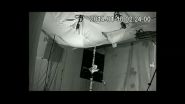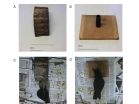INFORMATION:
Her research is supported by a grant from the National Institute on Deafness and Other Communication Disorders.
Quiet as a mouse, but so much to hear
UB researcher finds that mice discriminate partial sounds just as humans do with partial words
2014-12-04
(Press-News.org) BUFFALO, N.Y. -- Micheal L. Dent, a University at Buffalo psychologist, listens to what is inaudible to others. And what she's hearing might one day help us better understand human hearing loss.
Dent studies ultrasonic vocalizations (USVs) in mice. These sounds are above the human ear's upper limit, but they can be recorded and played back using specialized equipment that has allowed Dent to capture an impressive repertoire that when graphically represented shows a variety of sweeps, arcs, dips and curves. The tempo and intensity of these vocalizations change, as does their frequency bandwidth and the amount of frequency and amplitude modulation.
"There is so much complexity in these USVs," said Dent, an associate professor of psychology in the UB College of Arts and Sciences.
A downloadable photo of Dent is available here: http://www.buffalo.edu/news/releases/2014/12/012.html.
Several studies suggest that mice use these vocalizations for acoustic communication, but it's not conclusive whether USVs, in fact, carry meaning. Though diverse, the resulting array is still not entirely understood, so Dent is first trying to learn if mice can tell the difference between the vocalizations.
If these USVs are behaviorally relevant to the mice, then being able to perceive and identify them accurately in the environment, even when portions of the calls are perceptually masked, would be beneficial to an individual's survival, she writes in the study, "Discrimination of partial from whole ultrasonic vocalizations using a go/no-go task in mice," with UB graduate students David P. Holfoth and Erikson G. Neilans. The study was published in the December edition of the Journal of the Acoustical Society of America.
Mice are being used increasing as models because their inner ear structure and auditory system organization are similar to humans. Mice also progressively lose their hearing and are completely deaf at 18 months old. They also have what Dent says is an undeserved reputation as being uncooperative subjects for behavioral research.
"It has been said that mice can't be trained. We have found that's not the case. We train them to detect sounds, discriminate between sounds, localize sounds and categorize sounds using operant conditioning and positive reinforcement," she said.
For the current study, calls were broken into pieces to determine which piece led to better recognition of the whole call. It turns out that mice perceive the partial vocalizations as humans do with word onsets, in that each finds the beginning of the USV or word more similar to the whole than its ending.
"This result is an interesting parallel between two seemingly very different communication systems," said Dent.
Dent says these results don't prove the vocalizations have meaning, but they do at least point toward communication purposes. "Otherwise there would be no difference in the discrimination of the beginning of the vocalization as opposed to the end of the vocalization," she said.
The research is still in its infancy, but Dent believes this work strengthens the utility of mice as good models for human communication.
ELSE PRESS RELEASES FROM THIS DATE:
Two in 100 adults seriously considered suicide in 2013, CAMH survey shows
2014-12-04
TORONTO, Dec. 4, 2014 - Results from an ongoing survey conducted by the Centre for Addiction and Mental Health (CAMH) show that 2.2 per cent of adults --or over 230,000 people in Ontario, Canada -- seriously contemplated suicide in the last year. The 2013 edition of the CAMH Monitor, released today, included questions about suicidal ideation for the first time in the survey's history.
"Suicide is a major public health issue, and these data confirm that large numbers of Ontario adults report having suicidal thoughts," said Dr. Hayley Hamilton, CAMH scientist and co-principal ...
Endocrine disruptors alter thyroid levels in pregnancy, may affect fetal brain development
2014-12-04
AMHERST, Mass. - A new study led by biologist R. Thomas Zoeller of the University of Massachusetts Amherst provides "the strongest evidence to date" that endocrine disrupting chemicals such as polychlorinated biphenyls (PCB) found in flame retardant cloth, paint, adhesives and electrical transformers, can interfere with thyroid hormone action in pregnant women and may travel across the placenta to affect the fetus.
Results appeared in an early online edition and in the December print edition of the Endocrine Society's Journal of Clinical Endocrinology & Metabolism. ...
The walls can talk: New optical technique extracts audio from video
2014-12-04
BELLINGHAM, Washington, USA -- Those formerly silent walls can "talk" now: Researchers have demonstrated a simple optical technique by which audio information can be extracted from high-speed video recordings. The method uses an image-matching process based on vibration from sound waves, and is reported in an article appearing in the November issue of the journal Optical Engineering, published by SPIE, the international society for optics and photonics.
"One of the intriguing aspects of the paper is the ability to recover spoken words from a video of objects in the room," ...
Coordinating care of older adults moving across treatment still a problem
2014-12-04
In what is believed to be the first interview-style qualitative study of its kind among health care providers in the trenches, a team led by a Johns Hopkins geriatrician has further documented barriers to better care of older adults as they are transferred from hospital to rehabilitation center to home, and too often back again.
Using comments and concerns drawn from in-depth interviews of 18 physicians and two home health care agency administrators -- all experienced in trying to coordinate care of older adults -- the researchers created a framework for evaluating what ...
'Non-echolocating' fruit bats actually do echolocate, with wing clicks
2014-12-04
VIDEO:
A bat lands on the rewarded object in complete darkness (movie taken in IR). The movie shows that the bat has a general knowledge of the location of the object,...
Click here for more information.
In a discovery that overturns conventional wisdom about bats, researchers reporting in the Cell Press journal Current Biology on December 4 have found that Old World fruit bats--long classified as "non-echolocating"--actually do use a rudimentary form of echolocation. Perhaps ...
High-sugar diet in fathers can lead to obese offspring
2014-12-04
A new study shows that increasing sugar in the diet of male fruit flies for just 1 or 2 days before mating can cause obesity in their offspring through alterations that affect gene expression in the embryo. There is also evidence that a similar system regulates obesity susceptibility in mice and humans. The research, which is published online December 4 in the Cell Press journal Cell, provides insights into how certain metabolic traits are inherited and may help investigators determine whether they can be altered.
Research has shown that various factors that are passed ...
Why tool-wielding crows are left- or right-beaked
2014-12-04
New Caledonian crows--well known for their impressive stick-wielding abilities--show preferences when it comes to holding their tools on the left or the right sides of their beaks, in much the same way that people are left- or right-handed. Now researchers reporting in the Cell Press journal Current Biology on December 4 suggest that those bill preferences allow each bird to keep the tip of its tool in view of the eye on the opposite side of its head. Crows aren't so much left- or right-beaked as they are left- or right-eyed.
"If you were holding a brush in your mouth ...
Approved breast cancer drug offers hope for the treatment of blood disorders
2014-12-04
Blood cancers are more common in men than in women, but it has not been clear why this is the case. A study published by Cell Press December 4th in Cell Stem Cell provides an explanation, revealing that female sex hormones called estrogens regulate the survival, proliferation, and self-renewal of stem cells that give rise to blood cancers. Moreover, findings in mice with blood neoplasms--the excessive production of certain blood cells--suggest that a drug called tamoxifen, which targets estrogen receptors and is approved for the treatment of breast cancer, may also be a ...
Friendly bacteria are protective against malaria
2014-12-04
In a breakthrough study to be published on the December 4th issue of the prestigious scientific journal Cell, a research team led by Miguel Soares at the Instituto Gulbenkian de Ciência (IGC; Portugal) discovered that specific bacterial components in the human gut microbiota can trigger a natural defense mechanism that is highly protective against malaria transmission.
Over the past few years, the scientific community became aware that humans live under a continuous symbiotic relationship with a vast community of bacteria and other microbes that reside in the gut. ...
Female sex hormones can protect against the development of some blood disorders
2014-12-04
This discovery has a potential application in the treatment of certain blood disorders for which there is currently no cure. The study was led by Dr. Simón Méndez-Ferrer of the CNIC, working in partnership with the laboratories of Doctors Jürg Schwaller and Radek Skoda of the University Hospital in Basel (Switzerland). The study's authors have demonstrated in mice that tamoxifen, a drug already approved and widely used for the treatment of breast cancer, blocks the symptoms and the progression of a specific group of blood disorders known as myeloproliferative ...
LAST 30 PRESS RELEASES:
Low daily alcohol intake linked to 50% heightened mouth cancer risk in India
American Meteorological Society announces Rick Spinrad as 2026 President-Elect
Biomass-based carbon capture spotlighted in newly released global climate webinar recording
Illuminating invisible nano pollutants: advanced bioimaging tracks the full journey of emerging nanoscale contaminants in living systems
How does age affect recovery from spinal cord injury?
Novel AI tool offers prognosis for patients with head and neck cancer
Fathers’ microplastic exposure tied to their children’s metabolic problems
Research validates laboratory model for studying high-grade serous ovarian cancer
SIR 2026 delivers transformative breakthroughs in minimally invasive medicine to improve patient care
Stem Cell Reports most downloaded papers of 2025 highlight the breadth and impact of stem cell research
Oxford-led study estimates NHS spends around 3% of its primary and secondary care budget on the health impacts of heat and cold in England
A researcher’s long quest leads to a smart composite breakthrough
Urban wild bees act as “microbial sensors” of city health.
New study finds where you live affects recovery after a hip fracture
Forecasting the impact of fully automated vehicle adoption on US road traffic injuries
Alcohol-related hospitalizations from 2016 to 2022
Semaglutide and hospitalizations in patients with obesity and established cardiovascular disease
Researchers ‘listen in’ to embryo-mother interactions during implantation using a culture system replicating the womb lining
How changing your diet could help save the world
How to make AI truly scalable and reliable for real-time traffic assignment?
Beyond fragmented markets: A new framework for efficient and stable ride-pooling
Can shape priors make road perception more reliable for autonomous driving?
AI tracks nearly 100 years of aging research, revealing key trends and gaps
Innovative techniques enable Italy’s first imaging of individual trapped atoms
KIER successfully develops Korea-made “calibration thermoelectric module” for measuring thermoelectric device performance
Diversifying US Midwest farming for stability and resilience
Emphasizing immigrants’ deservingness shifts attitudes
Japanese eels, climate change, and river temperature
Pusan National University researchers discover faster, smarter heat treatment for lightweight magnesium metals
China’s 2024 Gastroenterology Report: marked progress in endoscopy quality and disease management
[Press-News.org] Quiet as a mouse, but so much to hearUB researcher finds that mice discriminate partial sounds just as humans do with partial words





